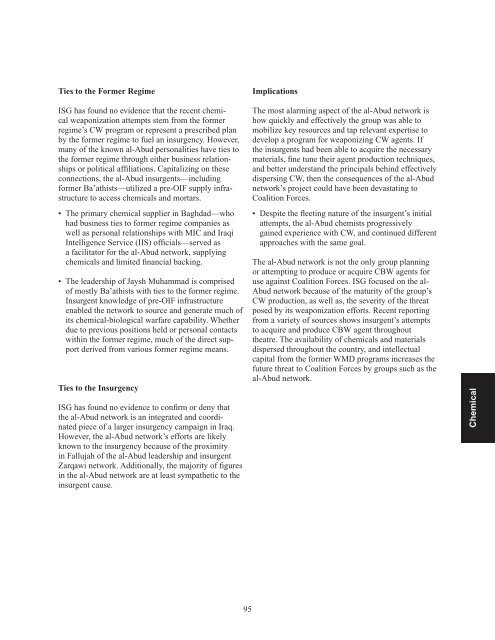Comprehensive Report
GPO-DUELFERREPORT-3
GPO-DUELFERREPORT-3
- No tags were found...
Create successful ePaper yourself
Turn your PDF publications into a flip-book with our unique Google optimized e-Paper software.
Ties to the Former Regime<br />
Implications<br />
ISG has found no evidence that the recent chemical<br />
weaponization attempts stem from the former<br />
regime’s CW program or represent a prescribed plan<br />
by the former regime to fuel an insurgency. However,<br />
many of the known al-Abud personalities have ties to<br />
the former regime through either business relationships<br />
or political affiliations. Capitalizing on these<br />
connections, the al-Abud insurgents—including<br />
former Ba’athists—utilized a pre-OIF supply infrastructure<br />
to access chemicals and mortars.<br />
• The primary chemical supplier in Baghdad—who<br />
had business ties to former regime companies as<br />
well as personal relationships with MIC and Iraqi<br />
Intelligence Service (IIS) officials—served as<br />
a facilitator for the al-Abud network, supplying<br />
chemicals and limited financial backing.<br />
• The leadership of Jaysh Muhammad is comprised<br />
of mostly Ba’athists with ties to the former regime.<br />
Insurgent knowledge of pre-OIF infrastructure<br />
enabled the network to source and generate much of<br />
its chemical-biological warfare capability. Whether<br />
due to previous positions held or personal contacts<br />
within the former regime, much of the direct support<br />
derived from various former regime means.<br />
Ties to the Insurgency<br />
ISG has found no evidence to confirm or deny that<br />
the al-Abud network is an integrated and coordinated<br />
piece of a larger insurgency campaign in Iraq.<br />
However, the al-Abud network’s efforts are likely<br />
known to the insurgency because of the proximity<br />
in Fallujah of the al-Abud leadership and insurgent<br />
Zarqawi network. Additionally, the majority of figures<br />
in the al-Abud network are at least sympathetic to the<br />
insurgent cause.<br />
The most alarming aspect of the al-Abud network is<br />
how quickly and effectively the group was able to<br />
mobilize key resources and tap relevant expertise to<br />
develop a program for weaponizing CW agents. If<br />
the insurgents had been able to acquire the necessary<br />
materials, fine tune their agent production techniques,<br />
and better understand the principals behind effectively<br />
dispersing CW, then the consequences of the al-Abud<br />
network’s project could have been devastating to<br />
Coalition Forces.<br />
• Despite the fleeting nature of the insurgent’s initial<br />
attempts, the al-Abud chemists progressively<br />
gained experience with CW, and continued different<br />
approaches with the same goal.<br />
The al-Abud network is not the only group planning<br />
or attempting to produce or acquire CBW agents for<br />
use against Coalition Forces. ISG focused on the al-<br />
Abud network because of the maturity of the group’s<br />
CW production, as well as, the severity of the threat<br />
posed by its weaponization efforts. Recent reporting<br />
from a variety of sources shows insurgent’s attempts<br />
to acquire and produce CBW agent throughout<br />
theatre. The availability of chemicals and materials<br />
dispersed throughout the country, and intellectual<br />
capital from the former WMD programs increases the<br />
future threat to Coalition Forces by groups such as the<br />
al-Abud network.<br />
Chemical<br />
95


